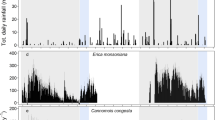Abstract
We contrasted the seasonal use of simulated large rain events (24 mm) by three native species of the arid Colorado Plateau: the perennial grass Hilaria jamesii and two shrubs Artemesia filifolia and Coleogyne ramosissima. Deuterium-enriched water was used to distinguish shallow "pulse" water from water in deeper soil layers that were unaffected by the water input. We also measured the leaf gas exchange rates of watered and unwatered control plants for 5 days after the rain event. H. jamesii had twice the pulse water proportion in its xylem than the two shrubs in spring (approx. 70% vs 35%). In summer, the pulse water proportions of all species were around 70%. The increase in the relative pulse water uptake of the two shrubs was caused primarily by a reduction in the rate of water uptake from deeper sources, consistent with the decrease in the availability of stored winter water. Rain increased the rates of gas exchange in C. ramosissima in both seasons, in H. jamesii only in summer and had no significant effect on A. filifolia. In H. jamesii, summer rain also increased water use efficiency. This suggests three principle mechanisms for rainwater use: (1) immediate increase in gas exchange via stomatal opening (C. ramisissima), (2) immediate increase in water use efficiency through restoration of the photosynthetic apparatus (H. jamesii) and (3) conservation of deeper soil water, potentially extending photosynthetic activity into later drought periods (A. filifolia). On a ground-area basis, A. filifolia was by far the largest consumer of spring and summer rain, due to its greater ground cover, while rain use by H. jamesii was negligible. We hypothesize that a population's fraction of the total community Leaf Area Index, more than species identity, determines which species takes up most of the spring and summer precipitation and we discuss this idea in the context of Walter and Stadelmann's (1974, In: Brown JW Jr (ed) Desert biology. Academic Press, New York, pp 213–310) water partitioning hypothesis.
Similar content being viewed by others
Author information
Authors and Affiliations
Additional information
Electronic Publication
Rights and permissions
About this article
Cite this article
Schwinning, S., Davis, K., Richardson, L. et al. Deuterium enriched irrigation indicates different forms of rain use in shrub/grass species of the Colorado Plateau. Oecologia 130, 345–355 (2002). https://doi.org/10.1007/s00442-001-0817-0
Received:
Accepted:
Published:
Issue Date:
DOI: https://doi.org/10.1007/s00442-001-0817-0




